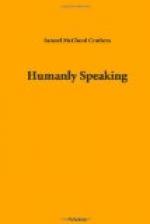Beside Landor there was only one other historic association which one could enjoy without getting drenched—that was St. David. In wading across the barnyard, I encountered “Boots,” an intelligent young man though unduly respectful. He informed me that the old building just across from the stable was the cell of St. David.
I was not prepared for this. All I knew was that St. David was the patron saint of Wales and had a cathedral and a number of other churches dedicated to him. Without too grossly admitting my ignorance, I tried to draw out from my mentor some further biographical facts that my imagination might work on during my stay. He thought that St. David was some relation to King Arthur, but just what the relation was, and whether he was only a relative by marriage, he didn’t know. It wasn’t very much information, but I was profoundly grateful to him.
I have since read a long article on St. David in the “Cambrian Plutarch.” The author goes into the question of the family relations between King Arthur and St. David with great thoroughness, but what conclusion he comes to is not quite evident. He thinks that the people are wrong who say that St. David was a nephew, because he was fifty years older than Arthur. That would make him more likely his uncle. But as he admits that King Arthur may possibly be another name for the constellation Ursa Major, it is difficult to fix the dates exactly. At any rate, the “Cambrian Plutarch” is sure that King Arthur was a Welshman and a credit to the country—and so was St. David. The author was as accurate in regard to the dates as the nature of his subject would allow. He adds apologetically, “It will appear that the life of St. David is rather misplaced with respect to chronological order. But as he was contemporary with all those whose lives have already been given, the anachronism, if such it may be called, can be of no great importance.”
That is just the way I feel about it. After living for a whole week in such close contact with the residence of St. David, I feel a real interest in him. Just who he was and when he lived, if at all, is a matter of no great importance.
* * * * *
Yet there are limits to the historical imagination. It must have something to work on, even though that something may be very vague. We must draw the line somewhere in our pursuit of antiquity. A relic may be too old to be effective. Instead of gently stimulating the imagination it may paralyze it. What we desire is not merely the ancient but the familiar. The relic must bring with it the sense of auld lang-syne. The Tory squire likes to preserve what has been a long time in his family. The traveler has the same feeling for the possessions of the family of humanity.
The family-feeling does not go back of a certain point. I draw the line at the legendary period when the heroes have names, and more or less coherent stories are told of their exploits, People who had a local habitation, but not a name, seem to belong to Geology only. For all their flint arrow-heads, or bronze instruments, I cannot think of them as fellow men.




